Associazione ESSPER
periodici italiani di economia, scienze sociali e storia
periodici italiani di economia, scienze sociali e storia
Autori: Focacci, Elena, Gerbella, Marzio
Titolo: Il ruolo del giro frontale inferiore e dei fascicoli uncinato ed occipitale inferiore nei processi di riconoscimento dei volti di natura emozionale
Periodico: Sistemi intelligenti
Anno: 2024 - Fascicolo: 1 - Pagina iniziale: 253 - Pagina finale: 273
The perception of faces expressing emotions is one of the most developed human visual abilities and involves various cortical and subcortical brain regions, such as some occipital and temporal areas, involved in the processing of pictorial aspects of the visual stimuli, and the amygdala, which plays a crucial role in assessing their emotional content. The first part of the article will review the classical models proposed to explain this particular perceptual process, while the second part will deal with the most recent evidence, which places emphasis on anatomical substrates not initially considered, and which leads to unprecedented interpretations of the processing of emotional facial expressions. Previous theoretical models described this brain function as the result of a modular analysis performed exclusively within the visual system and based on separate processing pathways for the recognition of the different visual features, such as identity and emotional expressions. Subsequent studies have suggested that the motor and prefrontal territories should be added to the classical regions considered as involved in the perception of faces. This evidence has prompted the proposal of new models that envisage an information processing not purely hierarchical but rather serial and/or based on top-down and simulation mechanisms. In line with this evidence, recent studies have emphasized the crucial role of the inferior frontal gyrus (IFG) for the explicit recognition of emotional facial expressions. While the anatomical pathways through which the occipital and temporal regions interact with each other are relatively well known, the connections between these regions and the IFG have not yet been studied in detail. Nonetheless, based on the data already present in the literature, it is possible to hypothesize that the inferior fronto-occipital and uncinate fasciculi represent the two preferential anatomical pathways through which this prefrontal region interacts with the visual regions during the processing of emotional faces. In particular, it is likely that the uncinate fasciculus is the route through which visual information from subcortical territories, including the colliculus, pulvinar, and amygdala, reaches the IFG, that in parallel receives further visual information from a cortical pathway constituted by temporal and the occipital areas and the inferior occipital fasciculus. Since lesion and functional studies suggest that the IFG plays a role in the conscious recognition of facial expressions, one intriguing hypothesis is that this ability emerges from the integration of purely visual cortical information with subcortical information, in which the visual aspects of stimuli are encoded unconsciously and in a rough way, but at the same time endowed with emotional content. The effects of the lesions of these fascicles support this hypothesis although specific studies are needed to test its actual validity..All this evidence suggests the intriguing hypothesis that the role of the IFG in the conscious recognition of facial expressions emerges from its capacity to integrate purely visual cortical information with subcortical one, in which the visual aspects of the stimuli are unconsciously and coarsely encoded, but at the same time endowed with emotional content. Although the effects of the lesions of these fasciculi support this hypothesis, specific studies are needed to test its actual validity.
SICI: 1120-9550(2024)1<253:IRDGFI>2.0.ZU;2-I
Testo completo: https://www.rivisteweb.it/download/article/10.1422/109013
Testo completo alternativo: https://www.rivisteweb.it/doi/10.1422/109013
Esportazione dati in Refworks (solo per utenti abilitati)
Record salvabile in Zotero
Biblioteche ACNP che possiedono il periodico
